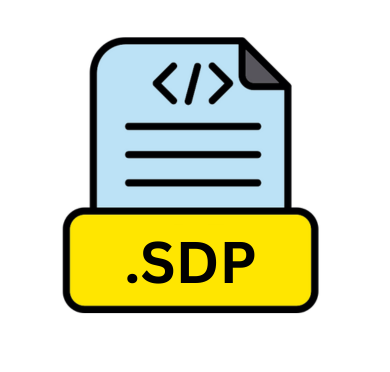.SDP File Extension

Session Description Protocol File
| Developer | N/A |
| Popularity | |
| Category | Data Files |
| Format | .SDP |
| Cross Platform | Update Soon |
What is an SDP file?
.SDP file extension, commonly associated with Session Description Protocol files, plays a crucial role in multimedia communication and conferencing over the Internet. .SDP files are pivotal for describing multimedia sessions and inviting participants to conferences.
They do not deliver media themselves but provide crucial details like session announcements, session invitations, and other session descriptions necessary for participants in multimedia sessions.
More Information.
The inception of the .SDP file dates back to the early development of Internet protocols for multimedia communication.
The primary objective of the .SDP was to provide a standard format to describe multimedia sessions to enable participants to join in.
It aimed at simplifying and standardizing the way multimedia communication sessions are initiated and managed over the Internet.
This protocol was essential in the early stages of internet telephony and video conferencing, paving the way for modern real-time communication technologies.
Origin Of This File.
The .SDP file format originates from the need to initialize and manage multimedia sessions over the internet. It is a format defined by the Internet Engineering Task Force (IETF) and documented as RFC 4566.
It was designed as part of the initiation protocol suite for internet conferencing, teleconferencing, and other large-scale multimedia communication.
File Structure Technical Specification.
The .SDP file is a text-based format, containing a series of descriptive lines that follow the key=value pattern.
Each line within the file represents a different aspect of the session description, starting with a unique character (key) followed by an equal sign and the descriptive information (value).
The main components of an .SDP file include:
- Version (
v=): Indicates the version of the .SDP in use. - Session Origin (
o=): Identifies the creator of the session and the session’s unique identifier. - Session Name (
s=): Provides the name of the session. - Timing (
t=): Specifies the start and stop times of the session. - Media Descriptions (
m=): Details the media type, port, protocol, and format.
These components, among others, collectively provide the information necessary for session initiation and participation.
How to Convert the File?
Converting .SDP files to another format is not a common operation since they are used specifically for session description and initiation.
Understanding and manipulating the content of .SDP files can be essential for developers and network administrators.
Tools and libraries that parse .SDP content can transform the session descriptions into various forms for analysis or integration into different applications.
Advantages And Disadvantages.
Advantages:
- Interoperability: As a standardized protocol, .SDP ensures a wide range of devices and applications can communicate effectively.
- Simplicity: The text-based, human-readable format makes it easy to create and debug.
- Extensibility: The format is designed to be extensible, allowing for the inclusion of new information as technology evolves.
Disadvantages:
- Lack of Security: .SDP itself does not include security specifications; it relies on underlying protocols for secure communication.
- Limited Session Control: While .SDP describes sessions, it does not manage or control them, depending on other protocols for these functions.
How to Open SDP?
Open In Windows
- Notepad: Being a text-based file,
.SDPfiles can be opened with simple text editors like Notepad. - SDP Multimedia: An application designed for opening and testing
.SDPfiles.
Open In Linux
- Vim or Nano: These command-line text editors can open
.SDPfiles for editing. - VLC Media Player: Similar to macOS, VLC on Linux can use
.SDPfiles to stream media.
Open In MAC
- TextEdit: The native text editor in macOS can open
.SDPfiles for viewing and editing. - VLC Media Player: This media player can interpret
.SDPfiles for streaming multimedia content.













